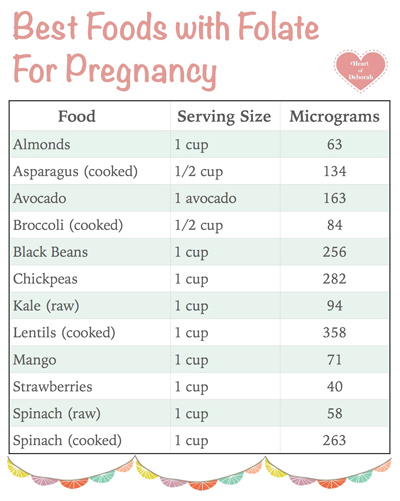Folate Rich Foods Chart for Pregnancy
Folate is an important nutrient for women and their babies before and during pregnancy. Many doctors along with the Center for Disease Control recommend women get 400 micrograms of folic acid everyday. Proper intake of folate reduces the risk of babies being born with serious neural tube defects. Prenatal vitamins often include folic acid in their formulas. I’m always a fan of getting nutrients from whole foods instead of synthetic sources. So I turned to food!
What are the most folate rich foods?
I wanted to ensure I was getting enough folate (the naturally occurring vitamin) versus folic acid (the synthetic form) so I created this chart when I was pregnant. I started measuring my folate intake a few months before I became pregnant and I continued to be aware of what I was eating throughout my pregnancy. I hope you find this information helpful in your journey to motherhood.

I tried to eat beans at least once a day since they are high in folate. I included beans on a salad, in soup, or in a quinoa dish!
Check out some of my favorite recipes when I was pregnant:
- Healthy Tortilla Soup
- Quinoa Salad with Black Beans & Avocado
- Easy Bean Burritos
- Quinoa Wrap with Black Beans









This is good to know. Also some cereals have folate in it
True cereals do contain folic acid. It is the synthetic form that is why I didn’t include it in my list. I tried to only include foods with folate, the naturally occurring form.
Great information here. I’ll tweet it out there!
Thanks! I’m glad you found it useful.
There is a fairly common genetic mutation that makes it super difficult to metabolize the synthetic folic acid and this problem remains widely unrecognized and undiagnosed. The mutation is abbreviated MTHFR and can cause a whole array of health problems. It’s a pretty interesting Google search!
There is a fairly common genetic mutation that makes it super difficult to metabolize the synthetic folic acid and this problem remains widely unrecognized and undiagnosed. The mutation is abbreviated MTHFR and can cause a whole array of health problems. It’s a pretty interesting Google search!
Some organizations now recommend between 0.4 – 0.8 mg (400-800 mcg) of folic acid just before and during early pregnancy. Many prenatals now actually contain 0.8 mg instead of 0.4.
Certain conditions may warrant consideration of larger doses. Some organizations, for example, suggest 4-5 mg of folic acid (10 times the dose) for those taking certain medications or those with diabetes. Some recommend high doses like these also for high-BMI women, while others don’t. Still other groups recommend that before conception, a woman at increased risk for NTDs simply measure red blood cell count folate concentration instead and take high-dose supplements only if they have low readings. Read more here:
http://womenshealth.gov/publications/our-publications/fact-sheet/folic-acid.html
http://www.ncbi.nlm.nih.gov/pubmed/18053387
http://www.hc-sc.gc.ca/fn-an/nutrition/prenatal/fol-qa-qr-eng.php
Remember, if you do take more folic acid, never take more than one prenatal vitamin to do so; additional folic acid should be added via supplements that contain only folic acid. Taking multiple prenatal vitamins would double up vitamins such as vitamin A, which can be harmful in too-large doses.
Definitely a topic for closer discussion with your care provider if you have risk factors to consider.